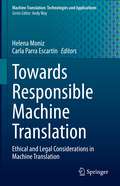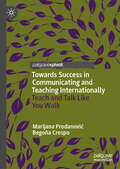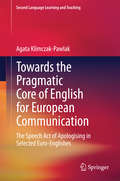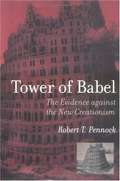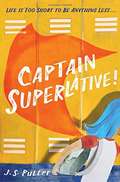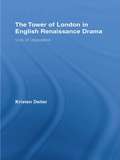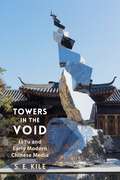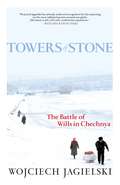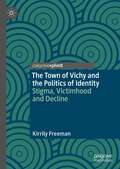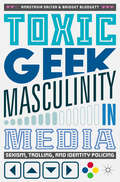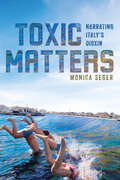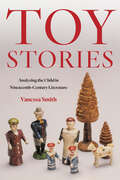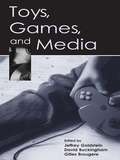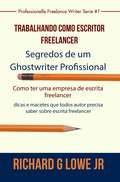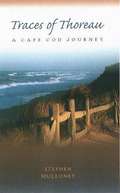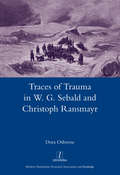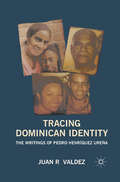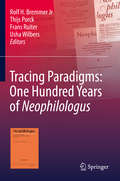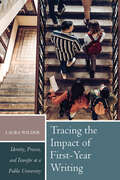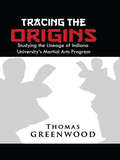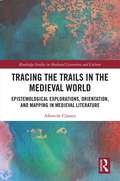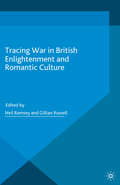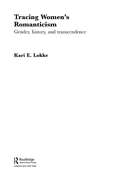- Table View
- List View
Towards Responsible Machine Translation: Ethical and Legal Considerations in Machine Translation (Machine Translation: Technologies and Applications #4)
by Helena Moniz Carla Parra EscartínThis book is a contribution to the research community towards thinking and reflecting on what Responsible Machine Translation really means. It was conceived as an open dialogue across disciplines, from philosophy to law, with the ultimate goal of providing a wide spectrum of topics to reflect on. It covers aspects related to the development of Machine translation systems, as well as its use in different scenarios, and the societal impact that it may have. This text appeals to students and researchers in linguistics, translation, natural language processing, philosophy, and law as well as professionals working in these fields.
Towards Success in Communicating and Teaching Internationally: Teach and Talk Like You Walk
by Marijana Prodanović Begoña CrespoThis book is an accessibly-written guide to international communicating and teaching practices. Intended for teachers and practitioners, it is written in a reader-friendly way in order to answer some common questions, and overcome obstacles that arise when interacting internationally. Cross-cultural encounters are often burdened with stereotypes, prejudices and misconceptions, which can lead to unwanted outcomes, miscommunication, and even result in total pragmatic failure. The situation becomes even more delicate when the paths of intercultural communication and teaching-learning processes cross. Its style, form and content make this book a vital resource for students, scholars, teachers, and practitioners working in fields such as applied linguistics, cross-cultural pragmatics, education and teaching, cultural studies, as well as international management.
Towards the Pragmatic Core of English for European Communication
by Agata Klimczak-PawlakEnglish in Europe is not one but many, and substantial differences in the way people from different countries communicate using it may cause misunderstandings. This book shows that, through research into the pragmatic behaviour of non-native speakers of English from across Europe, it is possible to uncover the core-the shared strategies. This common pragmatic linguistic behaviour is proposed as the basis for a reference guide for those who wish to successfully communicate in English in Europe. The study reported on in this book is based on the analysis of the speech act of apologizing as realized by 466 respondents from 8 European countries, all proficient users of English involved in teacher-training programmes. The results Provide a basis for practical teaching and in-class research.
Tower of Babel: The Evidence Against the New Creationism
by Robert T. PennockFinalist in the ForeWord Magazine Book of the Year Awards. Creationism is no longer the simple notion it once was taken to be. Its new advocates have become more sophisticated in how they present their views, speaking of "intelligent design" rather than "creation science" and aiming their arguments against the naturalistic philosophical method that underlies science, proposing to replace it with a "theistic science." The creationism controversy is not just about the status of Darwinian evolution--it is a clash of religious and philosophical worldviews, for a common underlying fear among Creationists is that evolution undermines both the basis of morality as they understand it and the possibility of purpose in life. In Tower of Babel, philosopher Robert T. Pennock compares the views of the new creationists with those of the old and reveals the insubstantiality of their arguments. One of Pennock's major innovations is to turn from biological evolution to the less charged subject of linguistic evolution, which has strong theoretical parallels with biological evolution, both in content and in the sort of evidence scientists use to draw conclusions about origins. Of course, an evolutionary view of language does conflict with the Bible, which says that God created the variety of languages at one time as punishment for the Tower of Babel. Several chapters deal with the work of Phillip Johnson, a highly influential leader of the new Creationists. Against his and other views, Pennock explains how science uses naturalism and discusses the relationship between factual and moral issues in the creationism-evolution controversy. The book also includes a discussion of Darwin's own shift from creationist to evolutionist and an extended argument for keeping private religious beliefs separate from public scientific knowledge.
A Tower of Giraffes: Animal Bunches
by Anna WrightA drove of pigs, a romp of otters, an ostentation of peacocks, and a tower of giraffes. . . . This clever book introduces young readers to some of the words we use to refer to animals in a group. The ink, watercolor, and fabric collage art is brightly colored and uniquely sets this fun book apart from the crowd. Each page presents information about an animal and its group behavior, such as how geese fly in a V-shape and honk to encourage the leaders, and that sometimes tens of thousand of flamingos meet up in one location. <P><P>Lexile Measure: AD940L
The Tower of London in English Renaissance Drama: Icon of Opposition (Literary Criticism and Cultural Theory)
by Kristen DeiterThe Tower of London in English Renaissance Drama historicizes the Tower of London's evolving meanings in English culture alongside its representations in twenty-four English history plays, 1579-c.1634, by William Shakespeare, Christopher Marlowe and others. While Elizabeth I, James I, and Charles I fashioned the Tower as a showplace of royal authority, magnificence, and entertainment, many playwrights of the time revealed the Tower's instability as a royal symbol and represented it, instead, as an emblem of opposition to the crown and as a bodily and spiritual icon of non-royal English identity.
Towers in the Void: Li Yu and Early Modern Chinese Media
by S. E. KileThe maverick cultural entrepreneur Li Yu survived the tumultuous Ming-Qing dynastic transition of the mid-seventeenth century through a commercially successful practice founded on intermedial experimentation. He engaged an astonishingly broad variety of cultural forms: from theatrical performance and literary production to fashion and wellness; from garden and interior design to the composition of letters and administrative documents. Drawing on his nonliterary work to reshape his writing, he translated this wide-ranging expertise into easily transmittable woodblock-printed form. Towers in the Void is a groundbreaking analysis of Li Yu’s work across these varied fields. It uses the concept of media to traverse them, revealing Li Yu’s creative enterprise as a remaking of early modern media forms.S. E. Kile argues that Li Yu’s cultural experimentation exploits the seams between language and the tangible world. He draws attention to the materiality of particular media forms, expanding the scope of early modern media by interweaving books, buildings, and bodies. Within and across these media, Li Yu’s cultural entrepreneurship with the technology of the printed book embraced its reproducibility while retaining a personal touch. His literary practice informed his garden design and, conversely, he drew on garden design to transform the vernacular short story. Ideas for extreme body modification in Li Yu’s fiction remade the possibilities of real human bodies in his nonfiction writing. Towers in the Void calls for seeing books, bodies, and buildings as interlinked media forms, both in early modern China and in today’s media-saturated world, positioning the Ming and Qing as a crucial site of global early modern cultural change.
Towers of Stone: The Battle of Wills in Chechnya
by Wojciech Jagielski Soren A. GaugerIn Towers of Stone, award-winning Polish reporter Wojciech Jagielski brings into focus the tragedy of Chechnya, its inhabitants, and the war being waged there by a handful of desperate warriors against a powerful and much more numerous army. Jagielski's narrative is told through the lens of two men: Shamil Basaev, a hero to some, a dangerous warlord to others; and Aslan Maskhadov, a calculating and sober politician, who is viewed as a providential savior by some of his compatriots and a cowardly opportunist by the rest. Caught up in a war to which they owe everything and without which they could not live, the two fighters face enemy forces--and one another--in protean conflicts that prove hard to quell. Viewing the two men's personal story as a microcosm of the conflict threatening to devour a land and its peoples, Jagielski distills the bitter history of the region with forceful clarity.
The Town of Vichy and the Politics of Identity: Stigma, Victimhood and Decline
by Kirrily FreemanThis book explores the contours of civic identity in the town of Vichy, France. Over the course of its history, Vichy has been known for three things: its thermal spa resort; its products (especially Vichy water and Vichy cosmetics); and its role in hosting the État Français, France’s collaborationist government in the Second World War. This last association has become an obsession for the residents of Vichy, who feel stigmatized and victimized by the widespread habit of referring to France’s wartime government as the 'Vichy regime'. This book argues that the stigma, victimhood, and decline suffered by Vichyssois are best understood by placing Vichy’s politics of identity in a broader historical context that considers corporate, as well as social and cultural, history.
Toxic Geek Masculinity in Media: Sexism, Trolling, and Identity Policing
by Anastasia Salter Bridget BlodgettThis book examines changing representations of masculinity in geek media, during a time of transition in which “geek” has not only gone mainstream but also become a more contested space than ever, with continual clashes such as Gamergate, the Rabid and Sad Puppies’ attacks on the Hugo Awards, and battles at conventions over “fake geek girls.” Anastasia Salter and Bridget Blodgett critique both gendered depictions of geeks, including shows like Chuck and The Big Bang Theory, and aspirational geek heroes, ranging from the Winchester brothers of Supernatural to BBC’s Sherlock and the varied superheroes of the Marvel Cinematic Universe. Through this analysis, the authors argue that toxic masculinity is deeply embedded in geek culture, and that the identity of geek as victimized other must be redefined before geek culture and media can ever become an inclusive space.
Toxic Matters: Narrating Italy’s Dioxin (Under the Sign of Nature)
by Monica SegerIn Toxic Matters, Monica Seger considers two Italian environmental disasters: an isolated factory explosion in Seveso, just north of Milan, in 1976 and the ongoing daily toxic emissions from the Ilva steelworks in the Apulian city of Taranto. Both have exposed residents to high concentrations of the persistent organic pollutant known as dioxin. Although different in terms of geography and temporality, Seveso and Taranto are deeply united by this nearly imperceptible substance, and by the representational complexities it poses. They are also united by creative narrative expressions, in literary, cinematic, and other forms, that push back against dominant contexts and representations perpetuated by state and industrial actors.Seger traces a dialogue between Seveso and Taranto, exploring an interplay between bodies, soil, industrial emissions, and the wealth of dynamic particulate matter that passes in between. At the same time, she emphasizes the crucial function of narrative expression for making sense of this modern-day reality and for shifting existing power dynamics as exposed communities exercise their voices. While Toxic Matters, is grounded in Italian cases and texts, it looks outward to the pressing questions of toxicity, embodiment, and storytelling faced by communities worldwide.
Toy Stories: Analyzing the Child in Nineteenth-Century Literature
by Vanessa SmithToy Stories: Analyzing the Child in Nineteenth-Century Literature explores the stakes of recurrent depictions of children’s violent, damaging, and tenuously restorative play with objects within a long nineteenth century of fictional and educational writing. As Vanessa Smith shows us, these scenes of aggression and anxiety cannot be squared with the standard picture of domestic childhood across that period. Instead, they seem to attest to the kinds of enactments of infant distress we would normally associate with post-psychoanalytic modernity, creating a ripple effect in the literary texts that nest them: regressing developmental narratives, giving new value to wooden characters, exposing Realism’s solid objects to odd fracture, and troubling distinctions between artificial and authentic interiority. Toy Stories is the first study to take these scenes of anger and overwhelm seriously, challenging received ideas about both the nineteenth century and its literary forms. Radically re-conceiving nineteenth-century childhood and its literary depiction as anticipating the scenes, theories, and methodologies of early child analysis, Toy Stories proposes a shared literary and psychoanalytic discernment about child’s play that in turn provides a deep context for understanding both the “development” of the novel and the keen British uptake of Melanie Klein’s and Anna Freud’s interventions in child therapy. In doing so, the book provides a necessary reframing of the work of Klein and Freud and their fractious disagreement about the interior life of the child and its object-mediated manifestations.
Toys, Games, and Media
by Jeffrey Goldstein David Buckingham Gilles BrougéreThis book is a state-of-the-art look at where toys have come from and where they are likely to go in the years ahead. The focus is on the interplay between traditional toys and play, and toys and play that are mediated by or combined with digital technology. As well as covering the technical aspects of computer mediated play activities, the authors consider how technologically enhanced toys are currently used in traditional play and how they are woven into childrens' lives. The authors contrast their findings about technologically enhanced toys with knowledge of traditional toys and play. They link their studies of toys to goals in education and to entertainment and information transfer.This book will appeal to students, researchers, teachers, child care workers and more broadly the entertainment industry. It is appropriate for courses that deal with the specialized subject of toys and games, media studies, education and teacher training, and child development.
Trabalhando como Escritor Freelancer – Segredos de um Ghostwriter Profissional
by Richard G Lowe JrEntão você acha que quer ser um ghostwriter freelancer? Talvez você tenha alguma experiência escrevendo ou queira ganhar um dinheiro extra. Talvez alguém pediu para você escrever um livro que queira publicar com seu próprio nome ou, possivelmente, você ouviu sobre essa coisa chamada ghostwriting e quis tentar. Ghostwriting é trabalho duro. É muito criativo e gratificante, no entanto, a energia requerida para entrar na mente de uma pessoa, ler seus cadernos, compreender suas notas manuscritas e transformar tudo isso em um manuscrito bem escrito é intenso. Ser escritor não significa que você tem as ferramentas para ser um bom ghostwriter. Ghostwriting requer todo um conjunto diferente de habilidades além de escrever. Você não está criando um livro para você; você está escrevendo um livro para satisfazer as necessidades e exigências de outra pessoa, empresa ou grupo. É algo muito diferente. Neste livro, você irá descobrir as porcas e parafusos da profissão e aprenderá como transformar com êxito a ideia de um cliente em um manuscrito completo.
Traces of Thoreau: A Cape Cod Journey
by Stephen MulloneyThe contemporary companion to Henry David Thoreau's classic Cape Cod.
Traces of Trauma in W. G. Sebald and Christoph Ransmayr
by Dora Osborne"Both W. G. Sebald (1944-2001) and the Austrian author Christoph Ransmayr (1954-) were born too late to know directly the violence of the Second World War and the Holocaust, but these traumatic events are a persistent presence in their work. In a series of close readings of key prose texts, Dora Osborne examines the different ways in which the traces of a traumatic past mark their narratives. By focusing on the authors' use of visual and topographical tropes, she shows how blind spots and inhospitable places configure signs of past violence, but, ultimately, resist our understanding. Whilst links between the two authors are well-documented, this book offers the first full-length study of Sebald and Ransmayr and their complicated relation to the traumatic traces of National Socialism. Dora Osborne is Lecturer in German at the University of Nottingham."
Tracing Dominican Identity
by Juan R. ValdezThe author analyzes and discusses the socio-historical meanings and implications of Pedro Henríquez Ureña's (1884-1946) writings on language. This important twentieth century Latin American intellectual is an unavoidable reference in Hispanic Linguistics and Cultural Studies.
Tracing Paradigms: One Hundred Years of Neophilologus
by Rolf H. Bremmer Jr Thijs Porck Frans Ruiter Usha WilbersThis volume brings together a selection of pivotal articles published in the hundred years since the launch of the journal Neophilologus. Each article is accompanied by an up-to-date commentary written by former and current editors of the journal. The commentaries position the articles within the history of the journal in particular and within the field of Modern Language Studies in general. As such, this book not only outlines the history of a scholarly journal, but also the history of an entire field. Over the course of its first one hundred years, 1916 to 2016, Neophilologus: An International Journal of Modern and Mediaeval Language and Literature has developed from a modest quarterly set up by a group of young and ambitious Dutch professors as a platform for their own publications to one of the leading international journals in Modern Language Studies. Although Neophilologus has remained broad-scope, multilingual and multidisciplinary, it has witnessed dramatic changes in its long-standing history: paradigm shifts, the rise and fall of literary theories, methods and sub-disciplines, as has the field of Modern Language Studies itself.
Tracing the Connected Narrative
by Janice CavellBy the 1850s, journalists and readers alike perceived Britain's search for the Northwest Passage as an ongoing story in the literary sense. Because this 'story' appeared, like so many nineteenth-century novels, in a series of installments in periodicals and reviews, it gained an appeal similar to that of fiction. Tracing the Connected Narrative examines written representations of nineteenth-century British expeditions to the Canadian Arctic. It places Arctic narratives in the broader context of the print culture of their time, especially periodical literature, which played an important role in shaping the public's understanding of Arctic exploration.Janice Cavell uncovers similarities between the presentation of exploration reports in periodicals and the serialized fiction that, she argues, predisposed readers to take an interest in the prolonged quest for the Northwest Passage. Cavell examines the same parallel in relation to the famous disappearance and subsequent search for the Franklin expedition. After the fate of Sir John Franklin had finally been revealed, the Illustrated London News printed a list of earlier articles on the missing expedition, suggesting that the public might wish to re-read them in order to 'trace the connected narrative' of this chapter in the Arctic story. Through extensive research and reference to new archival material, Cavell undertakes this task and, in the process, recaptures and examines the experience of nineteenth-century readers.
Tracing the Impact of First-Year Writing: Identity, Process, and Transfer at a Public University
by Laura WilderTracing the Impact of First-Year Writing presents the results of a large-scale longitudinal study of college writers that explores the impact of a required first-year writing course with a comparative approach not previously available. Over five years Laura Wilder conducted 143 interviews with, and collected 774 pages of writing from, 58 students, half of whom had taken a new first-year writing course and half who had not. Wilder found that while in many ways the experiences of both groups are comparable—demonstrating how students receive valuable educations in rhetoric and writing from a variety of sources beyond a first-year writing course—students who took the first-year writing course were much more likely to identify as writers. This identification supported students’ use of writing in powerfully generative and knowledge-building ways that they carried with them long after the course into other appropriate contexts. In contrast to previous longitudinal studies of college writers undertaken at institutions with high prestige and resources, Tracing the Impact of First-Year Writing explores the role of writing at a regional public university and documents how students’ experiences with writing can be highly divergent across the curriculum and unequal across campuses. Additionally, this book includes the voices of students who do not identify as capable writers and have strongly negative emotional reactions to writing and writing instruction and adds empirical support to innovative calls in the field to transform the first-year writing course into one that inspires students to reflectively consider writing itself.
Tracing the Origins: Studying the Lineage of Indiana University’s Martial Arts Program
by Thomas GreenwoodTracing the Origins is a book in three parts. The first is a personal history of the author as it relates to martial arts. The second is an ethnographical study of the authors martial lineage and more importantly the ways in which lineage functions. Lastly are the transcriptions of the interviews the author conducted in pursuit of this work. Tracing the Origins should prove especially interesting to those interested in the field of ethnography as it relates to martial arts and lineage.
Tracing the Trails in the Medieval World: Epistemological Explorations, Orientation, and Mapping in Medieval Literature
by Albrecht ClassenEvery human being knows that we are walking through life following trails, whether we are aware of them or not. Medieval poets, from the anonymous composer of Beowulf to Marie de France, Hartmann von Aue, Gottfried von Strassburg, and Guillaume de Lorris to Petrarch and Heinrich Kaufringer, predicated their works on the notion of the trail and elaborated on its epistemological function. We can grasp here an essential concept that determines much of medieval and early modern European literature and philosophy, addressing the direction which all protagonists pursue, as powerfully illustrated also by the anonymous poets of Herzog Ernst and Sir Gawain and the Green Knight. Dante’s Divina Commedia, in fact, proves to be one of the most explicit poetic manifestations of the fundamental idea of the trail, but we find strong parallels also in powerful contemporary works such as Guillaume de Deguileville’s Pèlerinage de la vie humaine and in many mystical tracts.
Tracing War in British Enlightenment and Romantic Culture (Palgrave Studies in the Enlightenment, Romanticism and Cultures of Print)
by Gillian Russell Neil RamseyThis volume argues for the enduring and pervasive significance of war in the formation of British Enlightenment and Romantic culture. Showing how war throws into question conventional disciplinary parameters and periodization, essays in the collection consider how war shapes culture through its multiple, divergent, and productive traces.
Tracing Women's Romanticism: Gender, History, and Transcendence (Routledge Studies in Romanticism #Vol. 4)
by Kari E. LokkeAwarded the 2005 Jean-Pierre Barricelli Book Prize by the International Conference on Romanticism This book explores a cosmopolitan tradition of nineteenth-century novels written in response to Germaine de Staël's originary novel of the artist as heroine, corinne. The first book to delineate the contours of an international women's Romanticism, it argues that the künstlerromane of Mary Shelley, Bettine von Arnim, and George Sand offer feminist understandings of history and transcendence that constitute a critique of Romanticism from within. The book examines meditative, mystical and utopian visions of religious and artistic transcendence in the novels of women Romanticists as vehicles for the representation of a gendered subjectivity that seeks detachment and distance from the interests and strictures of the existing patriarchal social and cultural order. For these writers, the author argues, self-transcendence means an abandonment or dissolution of the individual self through political and spiritual efforts that culminate in a revelation of the divinity of a collective selfhood that comes into being through historical process.
Track Changes: A Literary History of Word Processing
by Matthew G. KirschenbaumWriting in the digital age has been as messy as the inky rags in Gutenberg's shop or the molten lead of a Linotype machine. Matthew Kirschenbaum examines how creative authorship came to coexist with the computer revolution. Who were the early adopters, and what made others anxious? Was word processing just a better typewriter, or something more?
